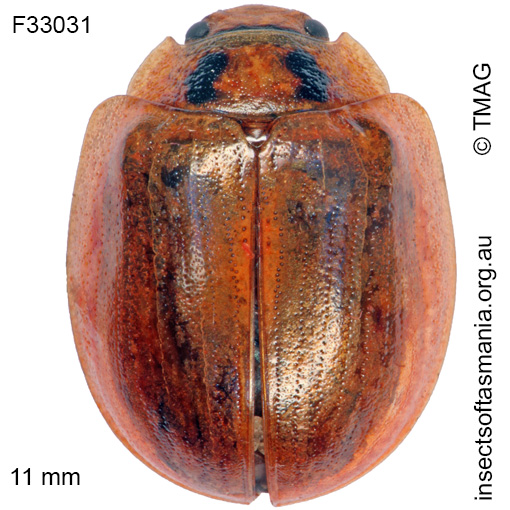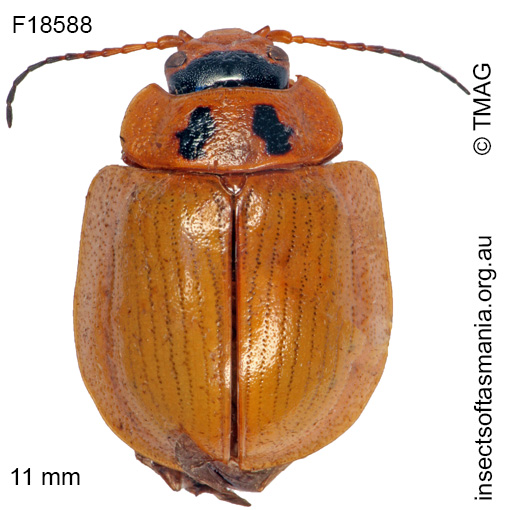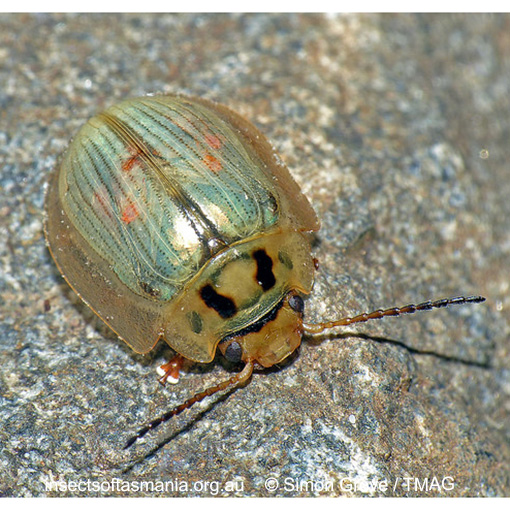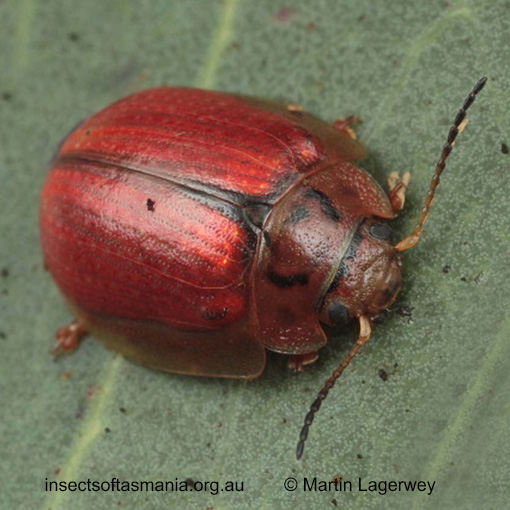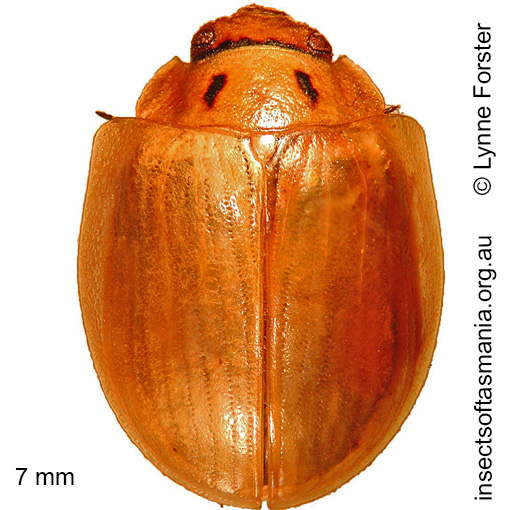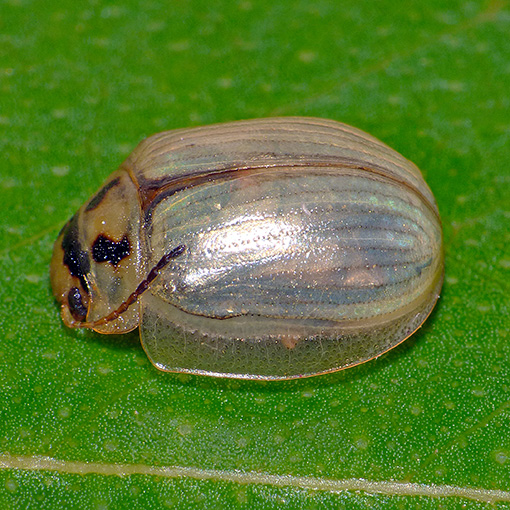
Paropsisterna bimaculata (Tasmanian eucalypt leaf-beetle)
Basis for Tasmanian occurrence
Classification
Suborder: Polyphaga
Superfamily: Chrysomeloidea
Family: Chrysomelidae
Subfamily: Chrysomelinae
Morphology
Flightedness: winged and assumed capable of flight
Source literature on morphology and taxonomy (*primary taxonomic source, where identified):
deLittle, D.W. (1979). Taxonomic and ecological studies of the Tasmanian eucalyptus-defoliating paropsids …, with particular reference to Chrysophtharta bimaculata. … PhD thesis, Univ. of Tasmania, Hobart.
Ecology
Association with dead wood or old trees: not saproxylic
Ecological attributes: — Can inflict significant damage on Eucalyptus spp. (Elliott & deLittle, 1985) — Larval development and survival higher on Eucalyptus nitens than on E. regnans (Baker et al., 2002) — May occupy logs or trunks of Eucalyptus obliqua, at least temporarily, since found having emerged within a year of felling (Grove & Bashford, 2003) — May occupy logs or trunks of Eucalyptus obliqua, at least temporarily, since found having emerged within six years of felling (Grove et al., 2009) — Predated by Cleobora mellyi and Harmonia conformis (Baker et al., 2003).
Collection method(s) for TMAG material: — Baited trapping (funnel trap) — Emergence trapping from cut billets of Eucalyptus obliqua (Harrison, 2007) — Emergence trapping from log of Eucalyptus obliqua — Flight intercept trapping (trough below Malaise trap) — Hand collection (substrate not specified) — Hand collection from Eucalyptus amygdalina/viminalis — Hand collection from Eucalyptus amygdalina — Hand collection from Eucalyptus delegatensis — Hand collection from Eucalyptus nitens — Hand collection from Eucalyptus obliqua — Hand collection from Eucalyptus regnans/viminalis — Hand collection from Eucalyptus regnans — Hand collection from Eucalyptus tenuiramis — Hand collection from Eucalyptus viminalis — Hand collection from Nothofagus cunninghamii — Hand collection from Pinus radiata — Hand collection from under bark (tree species not specified) — Hand collection from under bark of Eucalyptus delegatensis — Knockdown fogging of canopy of Eucalyptus obliqua — Knockdown spraying of bark of Eucalyptus obliqua — Knockdown spraying of bark of Eucalyptus sp. — Malaise trapping — Pitfall trapping — Sticky trapping on Eucalyptus obliqua — Trapping using a range of devices placed in crown of Eucalyptus obliqua (Bar-Ness, 2005) — Vane trapping.
Source ecological literature:
Elliott, H.J. (1990). The role of insects in changing forest vegetation in Tasmania. Tasforests 2(2): 111-116.
Grove, S.J. & Bashford, R. (2003). Beetle assemblages from the Warra log decay project: insights from the first year of sampling. Tasforests 14: 117-129.
Grove, S.J. (2009b). Beetles and fuelwood harvesting: a retrospective study from Tasmania’s southern forests. Tasforests 18: 77-99.
Elek, J.A. (1997). Assessing the impact of leaf beetles in eucalypt plantations and exploring options for their management. Tasforests 9: 139-154.
Leon, A. (1989). The Tasmanian Eucalyptus leaf beetle, Chrysophtharta bimaculata: an overview of the problem and current control methods. Tasforests1: 33-37.
Yee, M. et al. (2001). Not just waste wood: decaying logs as key habitats …: the ecology of large and small logs compared. Tasforests 13: 119-128.
Baker, S.C. (2000). Forest litter beetles and their habitat: a comparison of forest regenerated by wildfire and logging practices. Hons. thesis, Univ. of Tasmania, Hobart.
Baker, S.C. et al. (2002). Comparison of feeding efficiency, development time and survival of Tasmanian eucalyptus leaf beetle larvae Chrysophtharta bimaculata … on two hosts. Aust. J. Entom. 41: 174-181.
Baker, S.C. et al. (2003). Inundative release of coccinellid beetles into eucalypt plantations for biological control of chrysomelid leaf beetles. Agr. For. Entom. 5: 97-106.
Bar-Ness, Y. (2005). Crown structure and the canopy arthropod biodiversity of 100 year old and old-growth Tasmanian Eucalyptus obliqua. Msc thesis, Univ. of Tasmania, Hobart.
Bar-Ness, Y.D. et al. (2006). Age and distance effects on the canopy arthropod composition of old-growth and 100-year-old Eucalyptus obliqua trees. For. Ecol. Manage. 226: 290-298.
Beveridge, N. & Elek, J.A. (1999). Bacillus thuringiensis var. tenebrionis shows no toxicity to the predator Chauliognathus lugubris (F.) (Coleoptera : Cantharidae). Aust. J. Entom.38: 34-39.
Beveridge, N. & Elek, J.A. (2001 ). Insect and host-tree species influence the effectiveness of a Bacillus thuringiensis …-based insecticide for controlling chrysomelid leaf beetles. Aust. J. Entom. 40: 386-390.
Candy, S.G. & Baker, S.C. (2002). Calculating food consumption in the laboratory: a formula to adjust for natural weight loss. Aust. J. Entom.41: 170-173.
Candy, S.G. (2000). Predictive models for integrated pest management of the leaf beetle Chrysophtharta bimaculata in Eucalyptus nitens plantations in Tasmania. PhD thesis, Univ. of Tasmania.
Candy, S.G. >et al. (1992). Modelling the impact of defoliation by the leaf beetle Chrysophtharta bimaculata …on height growth of Eucalyptus regnans. For. Ecol. Manage. 54: 69-87.
Clarke, A.R. (1998). Day-degree estimates for the immature stages of the Tasmanian Eucalyptus leaf beetle Chrysophtharta bimaculata … Aust. Entom.25: 77-80.
Clarke, A.R. et al. (1998). Larval trapping as a means of sampling Paropsina (Coleoptera : Chrysomelidae : Chrysomelinae) from Eucalyptus forests. Col. Bull.52: 253-258.
Clarke, A.R. et al. (1997). Local dispersion of the Eucalyptus leaf-beetle, Chrysophtharta bimaculata (Coleoptera: Chrysomelidae), and implications for forest protection. J. Appl. Ecol. 34: 807-816.
Clarke, A.R. et al. (1998). Overwintering sites of Chrysophtharta bimaculata (Olivier) (Coleoptera: Chrysomelidae) in commercially managed Eucalyptus obliqua forests. Aust. J. Entom. 37: 149-154.
Congdon, B.C. et al. (1997). Geographical variation and gene flow in the eucalyptus defoliating beetle Chrysophtharta bimaculata (Coleoptera: Chrysomelidae). J. Appl. Ecol. 34: 1287-1292.
Davies, M. (1966). Neurosecretion in Chrysophtharta bimaculata. Hobart: Thesis, Dept. Zool., Univ. of Tasmania, 183 pages.
deLittle, D.W. (1982). Field parasitization of larval populations of the Eucalyptus-defoliating leaf-beetle, Chrysophtharta bimaculata … Gen. App. Entom. 14: 3-6.
deLittle, D.W. (1979b). Taxonomic and ecological studies of the Tasmanian eucalyptus-defoliating paropsids …, with particular reference to Chrysophtharta bimaculata …. PhD thesis, Univ. of Tasmania.
deLittle, D.W. (1983). Life-cycle and aspects of the biology of Tasmanian Eucalyptus leaf beetle, Chrysophtharta bimaculata (Olivier) (Coleoptera: Chrysomelidae). J. Aust. Entom. Soc. 29: 51-55.
deLittle, D.W. (1989). Paropsine chrysomelid attack on plantations of Eucalyptus nitens in Tasmania. J. For. Sci. 19: 223-227.
deLittle, D.W. et al. (1990). Stage-specific mortality in two field populations of immature Tasmanian eucalyptus leaf beetle, Chrysophtharta bimaculata … J. Aust. Entom. Soc. 29: 51-55.
deLittle, DW. & Madden, J.L (1975). Host preference in the Tasmanian eucalypt defoliating Paropsini … with particular reference to Chrysophtharta bimaculata…and C. agricola … J. Aust. Entom. Soc. 14: 387-394.
Elek, J. & Beveridge, N. (1999). Effect of a B… thuringiensis … insecticidal spray on the mortality, feeding, and development rates of larval Tasmanian Eucalyptus leaf beetles … J. Econ. Entom.92: 1062-1071.
Elliott, H. & Greener, A. (1993). Prospects for using B… thuringiensis to control eucalypt leaf beetles in Tasmania. In: Akhurst, R.J. (Ed.), Proc. 2nd Canberra Mtg on B. thuringiensis. CPN Publications, pp. 147-152.
Elliott, H.J. & deLittle, D.W. (1980). Laboratory studies on predation of Chrysophtharta bimaculata …eggs by the coccinellids Cleobora mellyi … and Harmonia conformis …. Gen. App. Entom. 12: 33-36.
Elliott, H.J. & deLittle, D.W. (1985). Insect pests of trees and timber in Tasmania. Hobart: Tas. Forestry Commission, 90 pages.
Elliott, H.J. et al. (1995). Control options for the leaf beetle, Chrysophtharta bimaculata … in eucalypt plantations in Tasmania. In: Proc. XX Int. Congr. Entom., Fireze, Italy, pp. 516-520.
Elliott, H.J. et al. (1992a). Effects of defoliation by the leaf beetle, Chrysophtharta bimaculata, on growth of Eucalyptus regnans plantations in Tasmania. Aust. For. 56: 22-26.
Elliott, H.J. et al. (1992b). Integrated pest management of the Tasmanian eucalyptus beetle Chrysophtharta bimaculata on growth of Eucalyptus regnans plantations in Tasmania. For. Ecol. Manage. 53: 229-238.
Elliott, H.J. et al. (1993). Effects of defoliation by the leaf beetle Chrysophtharta bimaculata on growth of Eucalyptus regnans plantations in Tasmania. Aust. For. 56 (1): 22-26.
Greener, A. & Candy, S.G. (1994). Effect of the biotic insecticide Bacillus thuringiensis and a pyrethroid on survival of predators of Chrysophtharta bimaculata … J. Aust. Entom. Soc. 33: 321-324.
Greener, A. & Candy, S.G. (1995). Effect of the biotic insecticide Bacillus thuringiensis on predators of Chrysophtharta bimaculata: Reply. J. Aust. Entom. Soc. 34: 99-100.
Grove, S. et al. (2009). A long-term experimental study of saproxylic beetle … succession in Tasmanian Eucalyptus … logs… In: Fattorini, S. (Ed.), Insect Ecology and Conservation. Research Signpost, pp. 71-114.
Grove, S.J. & Yaxley, B. (2005). Wildlife habitat strips and native forest ground-active beetle assemblages in plantation nodes in northeast Tasmania. Aust. J. Entom. 44 (4): 331-343.
Harcourt, R.L. et al. (1996). Effectiveness of purified Bacillus thuringiensis Berliner insecticidal proteins in control in three insect pests of Australian eucalypt plantations. J. Econ. Entom.89: 1392-1398.
Harrison, K.S. (2007). Saproxylic beetles associated with habitat features in Eucalyptus obliqua trees in the southern forests of Tasmania. PhD thesis, Dept. of Zoology, Univ. of Tasmania, Hobart.
Howlett, B.G. (2005). Failure of late instar larvae of the leaf beetle Chrysophtharta bimaculata, to establish on mature host Eucalyptus leaves. N.Z. Entom. 28: 65-69.
Howlett, B.G. & Clarke, A.R. (2003). Role of foliar chemistry versus leaf-tip morphology in egg-batch placement by Chrysophtharta bimaculata (Olivier) (Coleoptera: Chrysomelidae). Aust. J. Entom.42: 144-148.
Howlett, B.G. (2000). Oviposition site selection by the eucalypt herbivore Chrysophtharta bimaculata … and the implications for larval establishment. PhD thesis, Univ. of Tasmania, Hobart, 243 pages.
Howlett, B.G. et al. (2001). The influence of leaf age on the oviposition preference of Chrysophtharta bimaculata (Olivier) and the establishment of neonates. Agric. For. Entom.3: 121-127.
Jones, N.M. (2007). Tree fern invertebrates: variation of invertebrate assemblages on the tree fern Dicksonia antarctica and its quarantine applications. Hons. thesis, Univ. of Tasmania, Hobart.
Kile, G.A. (1974). Insect defoliation in eucalypt regrowth forests of southern Tasmania. Aust. For. Res.6: 9-18.
Kliejunas, J. T. & 9 others (2003). Pest risk assessment of the importation into the U.S. of unprocessed logs and chips of eighteen eucalypt species from Australia. Madison, WI: USDA Gen. Tech. Rep. FPL-137, 203 pages.
Lawrence, R. et al. (2003). Relative importance of plant ontogeny, host genetic variation, and leaf age for a common herbivore. Ecology 84: 1171-1178.
Madden, J.L. & Patel, V.S. (1995). Potential role of entomopathogens in the control of eucalypt defoliators. In: Proc. XX Int. Congr. Entom., Fireze, Italy, pp 516-518.
Mensah, R.K. & Madden, J.L. (1994). Conservation of two predator species for biological control of Chrysophtharta bimaculata (Col: Chrysomelidae) in Tasmanian forests. Entomophaga 39: 71-83.
Milner, R.J. & Akhurst, R.J. (1995). Effect of the biotic insecticide Bacillus thuringiensis on predators of Chrysophtharta bimaculata: A commEntom. J. Aust. Ent. Soc. 34: 97-98.
Nahrung, H. & Reid, C. (2002). Reproductive development of the Tasmanian eucalypt-defoliating beetles Chrysophtharta agricola (Chapuis) and C.bimaculata (Olivier) … Col. Bull. 56: 84-95.
Patterson, K.C. et al. (1996). Performance of first instar Chrysophtharta bimaculata larvae (Coleoptera: Chrysomelidae) on nine families of Eucalyptus regnans (Myrtaceae). Chemoecology 7: 94-106.
Raymond, C.A. (1995). Genetic variation in Eucalyptus regnans and E…nitens for levels of observed defoliation caused by … Chrysophtharta bimaculata …, in Tasmania. For. Ecol. Manage. 72: 21-29.
Raymond, C.A. (1998). Role of leaf development and colour change in differential defoliation of Eucalyptus regnans families by … Chrysophtharta bimaculata (Olivier). For. Ecol. Manage. 109: 75-84.
Smith, K. (2000). Spatial analysis of the Tasmanian Eucalyptus leaf beetle in relation to E. nitens plantations and landscape variables using GIS. Thesis, Univ. of Tasmania, 208 pages.
Steinbauer, M.J. et al. (1998). Oviposition preference of a Eucalyptus herbivore and the importance of leaf age on interspecific host choice. Env. Entom. 23: 201-206.
Taylor, R.J. (1990). Occurrence of log-dwelling invertebrates in regeneration and oldgrowth wet sclerophyll forest in southern Tasmania. Pap. Proc. Roy. Soc. Tas. 124: 27-34.
Yee, M. (2005). The ecology and habitat requirements of saproxylic beetles native to Tasmanian wet eucalypt forests: potential impacts of commercial forestry practices. PhD thesis, Univ. of Tasmania, Hobart.f Tasmania, Hobart.
